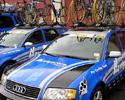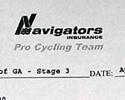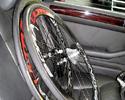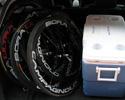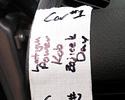
Recently on Cyclingnews.com |
Wrenchin' in the USA: The Chris Davidson diary 2007
Chris joins us again in 2007 to report on life on the road turning the wrench for a variety of teams both in dirt and on the road. Formerly with Ford Cycling in 2006, Chris has also worked for such teams as T-Mobile, Equipe Nurnberger, Quark and Mercury in the past, as well as neutral support programs with Shimano, Pedros and Trek.
As 2007 holds some new challenges for Chris, some things will stay the same. One of those will be his informative diary contributions on Cyclingnews, where you'll often receive the inside scoop on all things tech and a look at life behind the wrench.
A day in the car
Tour de Georgia - Stage 3 - April 18: Rome to Chattanooga, TN , 190.2km
Hi Cyclingnews fans, today I thought that it might be informative to show you what my 'office' looks like during the race. The tour of the back seat of our team caravan car highlighted the job requirements during a stage. And the best way to show all this is in pictures, so here goes:
The day always starts with a 'daily sheet', which I get the night before. This lists all the pertinent information for the next day's stage, i.e. times, locations etc. From this sheet we decide how early to get up and get to work. Typically, I try to be out at the truck, packed out of my hotel and ready to go, two hours before the 'bags out' time for the riders.
For vehicles, Navigators have two Audi A6 wagons. Good caravan cars, plenty of room, good handling and speed, and a few nice extras like heated rear leather seats and removable headrests.
So entering from the rear passenger door you begin to see all the things/modifications that are necessary for me to do my job. First off, I remove the headrest for the front seat to give me clear visibility through the front windshield at the race. Next I move the front passenger seat, in front of my position, all the way forward. This gives me more room to work in the back. You also might note that the door sill is filled with various feeding supplies for the riders. Sometimes the riders cannot get over to the director's side of the car, so I have to feed out the passenger side.
On the seat in front of me, I have taped a reference card for the current stage that lists the elevation profile and the key points (i.e. sprint, KOM, etc). On this piece of white tape I also have the names of the riders which depict the arrangement of the spare bikes on top of the car that I am in. Tucked in the seatback in front of me are more feeding items, a race start list for that specific stage, and a couple of writing utensils: usually a pen and a big sharpie. This gives me the ability to quickly write down the composition of the break, the riders picked for medical control etc.
On the floor in front of me I have a race tool bag with the essential tools for on the fly repairs. These are limited and hopefully never used, but you have to cover all the bases in case of 'unexpected problems' on the road. On the seat next to me I carry a pair of the race wheels for the day, with the cassette of choice for the stage, as the first set that I will leave the car with if a rider has a flat or there is a crash. The wheels are 'gapped' meaning that they have been checked in one of the team's frames such that there is no adjustment of the quick release skewer necessary when I go to install the new wheel during the race. This facilitates fast wheels changes, just slam it in the frame, close the lever, and push the rider off.
Over the seats behind me there are three more sets of spare wheels, 'gapped' and ready to go. These wheels get checked for pressure and gapping each day, whether they get used of not. Also behind me are the most important things in the car for the riders everyday, the cooler with extra bottles. Usually that soigneurs fill this with half water bottles, half drink mix bottles (mix bottles have an 'X' on them). We try and always start the stage with 40+ bottles in each of both cars. When we feed from the car, I typically pull out eight bottles at a time and hand them forward one-by-one to the director to hand the riders.
Up front I also prepare a piece of white tape for the director with a list/location of the spare bikes on top of both cars for his reference. I tape this to the dashboard on the left of the steering column (so when the director has to get out of the car and look for a specific bike on top, he knows where to go first). On the center of the dashboard, I have taped a start list for the director to reference while he is driving. He probably should not be looking at this too much while driving, but at least he does not need to have this in his hands all the time. Our team race radio is installed up from and the director likes to hang the microphone over the mirror up front such that the microphone hangs down for easy access.
So I sit in the back seat and wait for the bad stuff to happen during the stage. If no mechanical incidents happen, then I spend most of the day helping the director with the aspects of managing the race information, using radios, feeding riders, calculating splits, figuring the composition of the break. If all goes well, I don't have to get out of the car until the stage is over, and we have a successful day. If not, there might be wheel changes, bike changes, crash damage to assess and repair, etc. So far at the Tour of Georgia, through three stages I have only gotten out of the car during the race for a few 'nature breaks' (as the race radio likes to refer to them).
So there you go, a look into my 'office' during the road stages. Now off to wash some bikes...
Thanks,
Chris Davidson
Photography
For a thumbnail gallery of these images, click here
Images by Chris Davidson
- The 'daily sheet'.
- Welcome to the 'office' for the road stages.
- Plenty of food packed in to the door pockets of the backseat.
- Modifications to the back of the passenger side seat include removing the headrest, adding some rider food and supplies and diagramming the top of the car.
- The daily spares configuration and the course profile taped to the seat.
- My race tool kit sits on the floor.
- Spare set of wheels #1, gapped and ready to go.
- Spare sets of wheels #2-4 and the cooler sit behind me.
- The back of the wagon contains spare wheelsets and the cooler.
- The director's roof spare reference, taped on the dashboard up front on the left.
- The daily start list and the team radio setup.
- The Navigators roll in Audi A6 wagons.

